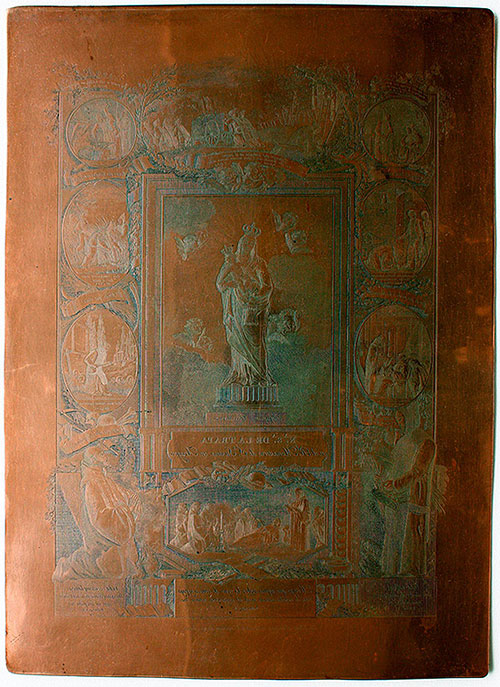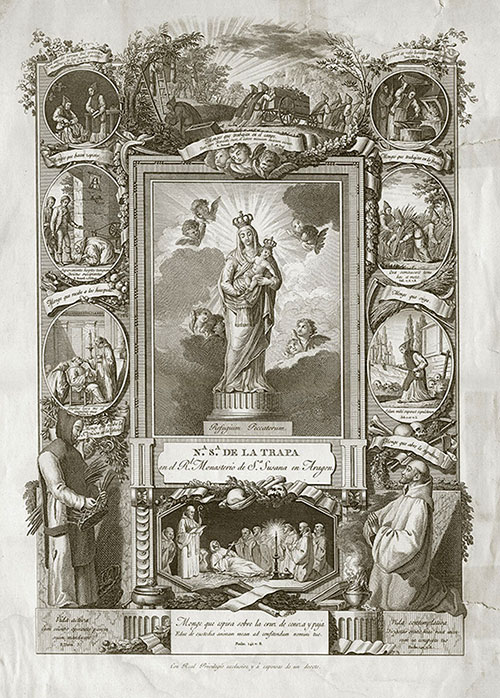The piece of the month of January 2022
OUR LADY OF LA TRAPA IN THE ROYAL MONASTERY OF SANTA SUSANA IN ARAGON
Luis José Roy Sinusía
University of Zaragoza
To the Cistercian abbey of the monastery of Santa María la Real de la Oliva belongs an intaglio print entitled Nuestra Señora de la Trapa in the Royal Monastery of Santa Susana in Aragón, the first monastery founded by the Trappist order in Spain in the town of Maella (Zaragoza).
It reproduces the image that occupied the main altar of his church, commissioned to the Alcañiz sculptor José Pelegrín by the Marquis of Santa Coloma, devotee of the Virgin, whose ancestral home was erected in the town of Alcañiz (Teruel). As model he was given an image with the invocation of the Trappe engraved in Barcelona to the devotion of Francisco Papiol, neighbor of Villanueva de Sitges (Vilanova i la Geltrú, Barcelona) who welcomed the founding father Gerásimo de Alcántara when he passed through that town, accompanied the community from the monastery of Poblet to the priory of Santa Susana and intervened as a witness in the cession of the monastery. We can probably identify the engraving, faithful to the carving of the primitive monastery of La Trappe in France, with the print signed by the renowned intaglio artist Pedro Pascual Moles and the painter Pedro Pablo Montaña, who provided the drawing. Once the image of the Virgin was sculpted, the aforementioned marquis, who made position of the expenses together with other devotees, had it blessed and exposed to public worship with a "magnificent and most devout" function in the church of Santiago de Alcañiz, taking it to the Trappist monastery with "great solemnity and accompaniment". There it was placed on the main altar, which provisional had been built in plaster, arousing great fervor and comfort to all the religious for the perfect resemblance to the original sculpture.

Virgen de la Trapa. Plate.
According to the handwriting at the bottom of the image, the work was paid for by an anonymous devotee, probably a leading figure who would offer his protection and influence to the order, and obtained an exclusive royal privilege, so that the monastery had the exclusive and legitimate right to distribute images of Nuestra Señora de la Trapa with the corresponding degree scroll. Thus, the rights of sale and printing were assigned to the sanctuary, forbidding engravers and printmakers to produce or sell images without the permission of the community.
However, this work, lacking signature and linked to the Aragonese monastery, presents an extraordinary coincidence with the proofs belonging to the University of Navarra and collections Antonio Correa of Madrid (Calcografía Nacional) and Lasarte of Zaragoza, signed by the Valencian engraver Francisco Jordán. The disparity is found in the degree scroll: "Nuestra Señora de la Trapa de España", in the proportion and slight variation of the text in some phylactery, signs of score and graphics used in the letter, leaf litter that adorns the upper zone and size of the pedestal in the lower part. The difference of the degree scroll would allow us to explain the coexistence of two practically identical works and of an even chronology, when one of them, probably the original work, was protected with the royal privilege.

Our Lady of La Trapa.
Both engravings show the Virgin standing, with a serene gesture and gaze directed downward, on a cylindrical fluted pedestal, which includes the registration "Refugium Peccatorum", and within a rectangular framework of academic taste, as if it were a painting. She wears a veil that encircles a closed crown and wears a tunic and mantle gathered in front. With her right hand, extended forward and represented foreshortened, she carries a "little pavilion" or "stole" that hid the ciborium where the consecrated hosts were kept, as a sign of reverence towards her Son, whom she supports with her left hand. Jesus appears naked, also crowned and imparting the blessing. In the background we observe open skies populated by a large angelic cohort.
Around them there are several vignettes, mainly medallions, of a narrative nature about the exercises and obligations of the monks, surrounded by phylacteries with identifying titles and sacred quotations related to the observance of their rule, as well as ornamental plant and allegorical motifs such as tibias, skulls and tools from work, a set that makes up an imaginary altarpiece. With a meticulous sense of detail, there are scenes of religious men carrying out the trades of shoemaker and blacksmith, picking fruit from the trees and transporting the harvest without animal traction, harvesting wheat and welcoming guests. A monk is also represented receiving the extreme unction, opening his grave and expiring on the ground on the cross of ash and straw, accompanied by the community in prayerful attitude and listening to the prayers read by the abbot.
In the lower left part, superimposed on the altarpiece and with a larger proportion, there is a monk standing weaving a basket, alluding to the active life, in which the work guide was of primary importance as a pious exercise, at the same time that it provided sustenance to the community and allowed the exercise of charity with pilgrims and the needy. On the right, another religious kneeling, joining hands and directing his gaze to the Virgin, represents the contemplative life and consecration of the Trappist monks to divine worship.
The careful iconographic program and the selection of inscribed texts lead us to suppose that the intellectual authorship would come from a religious member of the community, perhaps the abbot and founding father himself, who would provide precise indications to the experienced engraver in charge of opening the first plate.
We must add that the print, in addition to its edifying function and to promote the Marian devotion, has an apologetic character, so that the vignettes around the Virgin would have the purpose of showing the Spanish society and its rulers the benefit and usefulness of the observance practiced by the monks settled in Aragonese lands in 1796, after their expulsion from France due to the revolutionary events and forced pilgrimage.
Finally, it is worth relating the purpose and approximate chronology of the plate -between 1796 and 1797- with the publication of the Compendio de los exercicios, y obligaciones de los monges cistercienses de Nuestra Señora de la Trappa....ordered to be printed by the Count of Fuentes (Zaragoza, Francisco Magallón, 1796) and that shortly after would come out again in a "more complete and exact" reprint, financed, on this occasion, by an anonymous devotee (Madrid, Imprenta de Sancha, 1797). This last book is illustrated by a beautiful intaglio of Nuestra Señora de la Trapa, drawn and engraved by the Cadiz-born José Rico during his formative years at the Royal Academy of San Fernando, which presents significant coincidences with the image opened by Pedro Pascual Moles and, above all, with the pose and attitude of the Virgin that we appreciate in the plate kept in the monastery of Navarre.
*
Author: Anonymous.
degree scroll: Our Lady of the Trappist in the Royal Monastery of Santa Susana in Aragon.
Date: 1796-1797.
Technique: Etching and engraving.
Size: Plate, 402 x mm.
Inscribed: Quid impedit servum Dei operantem / manibus... in lege Domini meditavi.... / S. Aug.... 1. de O. M. 17. // Monges que hacen zapatos. // Monges que trabajan en el campo. / Tune vere Monachi sunt, si labore manuam suarum vivunt. / S. Bened. c. 48. Reg.... // Quis poterit ex vobis habitare cum igne devorante / Isai. 33. 14 // Monges who work at the forge // Supervenientes hospites tamquam / Christus suscipiantr. / S. Bened. c. 53. Rec. // Monge who receives guests. // Quae seminaverit homo / hac et metet. / Gal. c. 6. v. 8. // Monge who mows // Amplius lava me al / iniquitate mea. / Psalm. 50 v. Monge who receives the / Holy Unction in the Church. // Solum mihi superest sepulchrum / Job. c. 17. v. 1. // Monge who opens the sepulcher // Refugium Peccatorum. // N.A S. A DE LA TRAPA / in the R.l Monastery of S.a Susana in Aragon. // Active life / Cum silentio operantes panem / suum manducent / 2. Thess 3. // Monk breathing on the cross of ash and straw / Educ de custodia animam meam ad confitendum nomini tuo / Psalm. 141. v. 8. // Contemplative life / Dirigatur oratio mea sicut incen-/sum in conspectu tuo / Psalm. 140. v. 8. // With exclusive Royal Privilege, and at the expense of a devotee.
Provenance: Monastery of Santa María la Real de la Oliva, Carcastillo (Navarra).
Observations: An original stamp cut in blood belongs to the Zarazaga Aubá Collection in Zaragoza.
SOURCES AND BIBLIOGRAPHY
[ History of the Royal Monastery of Santa Susana de la Trapa. Volume I, p. 150.
[Without author], Compendio de los exercicios, y obligaciones de los monges cistercienses de Nuestra Señora de la Trappa..., Zaragoza, Francisco Magallón, 1796, pp. 16-21.
[ Compendio de los exercicios y obligaciones de los monges cistercienses de N. Señora de la Trapa. .. Madrid, Imprenta de Sancha, 1797, p. CXVII.
CEÁN BERMÚDEZ, J. A., Diccionario histórico de los más ilustres profesores de las Bellas Artes en España, Madrid, Imprenta de la Vda. de Ibarra, 1800 (vid. ed. Madrid, Reales Academias de San Fernando y de Historia, 1965), t. III, pp. 163-165.
OSSORIO Y BERNARD, M., Galería biográfica de artistas españoles del siglo XIX, Madrid, Imprenta de Moreno y Rojas, 1883-1884, pp. 351, 352 and 578.
SUBIRANA I REBULL, R. M., Pasqual Pere Moles i Corones. València 1741 - Barcelona 1797. Barcelona, Library Services de Catalunya, 1990, pp. 236-237.
ALARCÓN ROMÁN, C., "La iconografía religiosa en el siglo XVIII", Revista de dialectología y tradiciones popularesCuad. 45, 1990, pp. 247-278, esp. pp. 262 and 269.
CORREA, A. (coord.), "Diccionario crítico de grabadores valencianos del siglo XVIII", in Fernando Selma: el Grabado al Servicio de la Cultura Ilustrada (Catalog de la exhibition), Madrid-Valencia, Fundación La Caixa, 1993, pp. 135,139-140.
FERRI CHULIO, A. de Sales, El grabador Francisco Jordán: Muro (Alicante), 1765-Cartuja de Porta Coeli, 1832, Sueca, Imprenta de Luis Palacios, 2004, pp. 66-67.
COLLANTES GONZÁLEZ, J. M., "Nuevos, data en torno a la Sta. Cueva de Cádiz: notas sobre una estampa del grabador José Rico", Cuadernos de Ilustración y Romanticismo. Revista Digital del group de programs of study del Siglo XVIII. University of Cádiz, no. 21, 2015, pp. 267-279, esp. pp. 274-278.
https://revistas.uca.es/index.php/cir/article/view/2104/2028/
https://unika.unav.edu/discovery/fulldisplay?docid=alma991000637599708016&context=L&vid=34UNAV_INST:VU1/
https://www.academiacolecciones.com/estampas/inventario.php?id=AC-01476/
https://www.academiacolecciones.com/estampas/inventario.php?id=AC-01475/
https://www.academiacolecciones.com/estampas/inventario.php?id=AC-01477/
